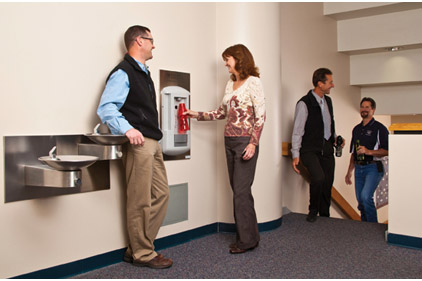Fixture requirements are a key discussion topic at ICC code hearings


|
| Photo courtesy of Haws Corp |
This was also the first cycle with Code Action Committees for plumbing, mechanical and fuel gas. The CAC is designed to flush out the difficult issues. The CAC process allows for a more in-depth discussion on key issues. Code hearings are limited to testimony of two minutes initially and one minute of rebuttal. However, the process can only be effective if the Code Change Committee accepts the code changes proposed by the CAC. In this cycle, the results were mixed with the CAC code changes. As an observer, I thought that many more of the CAC changes should have been approved.
With many new faces, everyone was curious as to how the new Plumbing Code Change Committee might fare. Unfortunately, they had one of the most difficult code changes coming to the floor within the first few minutes of the hearing. That change from the CAC would delete Chapter 13 on graywater and replace it with a new Chapter 13 and Chapter14 on reclaimed water and rainwater harvesting.
The discussion on the new chapters 13 and 14 centered around the change being taken from the Green Code, as well as it not being perfect. Of course, there has never been a perfect code change so expectations were unrealistic. As for being taken from the Green Code, the CAC representatives quickly pointed out that neither system was required; the change merely regulates the systems when a building owner chooses to install them.
During the committee discussion, it lost sight of the fact that the existing Chapter 13 is lousy. There is no better way to put it. Unfortunately wanting perfection, the committee recommended denial. It appeared the committee didn’t need such a difficult change when it was just getting started. The change probably would have fared better if it hit the agenda the following day.
Fixture talk
After recommending denial of this big CAC change, the committee settled down and did very well with many other controversial issues. As usual, the discussion on fixture requirements took a long time. There were many changes tinkering with the table on required fixtures. There were also changes regarding accessibility. One proposal that was accepted clarified that fixtures are to be supplied based on use of the building, not the use group. This will make the table more understandable for mixed use-type buildings.
One change proposed to add a requirement to have water-supplied fixtures upstream of nonwater-supplied urinals. This requirement currently appears in the Uniform Plumbing Code but has never been a part of the International Plumbing Code. This was a classic case of arguing hypotheticals, not fact. Those wanting a water supply fixture upstream of a nonwater-supplied urinal basically thought it was a good idea. The committee recommended denial, identifying that the code requirement has been longstanding and there is no technical justification for a change.
Another interesting change was the addition of bottle filling stations as a substitute for drinking fountains. It was pointed out that society is changing and many people are using their own water bottles. Furthermore, many of the younger generation consider drinking fountains to be unsanitary (even though they are not). The change did clarify that the sale of water cannot be used as a substitute for drinking fountains. That has always been the intent of the code.
One of the changes that resulted in some interesting discussion was the requirement for testing balanced pressure and thermostatic mixing valves. With the use of lower-flow showerheads, many shower valves are not tested for scald prevention at the lower flows. The change would require such testing at a flow rate of 1.5 gpm. The argument opposed to the change was that it would add costs to the manufacturer because of additional testing. The change was recommended for denial.
In the water supply chapter, all attempts to regulate the temperature of water were denied. The reason for denying the changes was based on the scald protection provided at the fixture.
The testimony on lowering of water usage rates seemed like a step back in time of about 20 years. There were those arguing the need to further conserve water, while the opposition claimed the fixtures weren’t good enough and the manufacturers need time to switch all their products. Finally, there were those who thought we already conserve enough water.
The two main arguments in opposition were flawed. The lower-flow fixtures are very good, much better than the original change to 1.6-gpf water closets and 3.0-gpm showerheads. As for providing time for the manufacturers, the code will not be issued until 2015. It will take jurisdictions another year or so to adopt the code. Hence, the manufacturers have more time than they did to make the original switch with the federal mandate. The changes were eventually recommended for denial.
Pipe, grease and storm drainage
In the various piping chapters, there were about 50 to 60 changes to the material and joints and connections requirements. Nothing was earth shattering; it was more of the addition of new standards and clarification of requirements.
The only significant change to the drainage and venting sections was the addition of vacuum drainage to the body of the code. Currently, vacuum drainage is found in the appendix. The committee recommended approval of the change to add the requirements to Chapter 7.
Two changes that were recommended for approval will add new requirements for sizing grease interceptors. One change deals with hydromechanical grease interceptors, the other is for sizing the larger gravity grease interceptors.
A series of changes were proposed to the storm drainage chapter. The changes would result in an entirely new way of sizing a storm drainage system. The sizing would be based on the flow through a roof drain as opposed to the current requirement for sizing based on the pipe capacity. The changes are based on the results of research done by the ASPE Research Foundation with sponsorship from IAPMO. Unfortunately, the paper on the research has not yet been published. As a result, the committee recommended denial, pending the publication of the research report. The committee did, however, state that if the report provides such technical backup, it is in agreement with the changes.
The results of the hearing are available on the ICC website at www.iccsafe.org. Public comments to the committees’ recommendations must be submitted by Aug. 1, 2012. All public comments will be heard at the final hearing Oct. 24-28, 2012 in Portland, Ore.
A series of changes were proposed to the storm drainage chapter. The changes would result in an entirely new way of sizing a storm drainage system. The sizing would be based on the flow through a roof drain as opposed to the current requirement for sizing based on the pipe capacity. The changes are based on the results of research done by the ASPE Research Foundation with sponsorship from IAPMO. Unfortunately, the paper on the research has not yet been published. As a result, the committee recommended denial, pending the publication of the research report. The committee did, however, state that if the report provides such technical backup, it is in agreement with the changes.
The results of the hearing are available on the ICC website. Public comments to the committees’ recommendations must be submitted by Aug. 1, 2012. All public comments will be heard at the final hearing Oct. 24-28, 2012 in Portland, Ore.
Looking for a reprint of this article?
From high-res PDFs to custom plaques, order your copy today!





